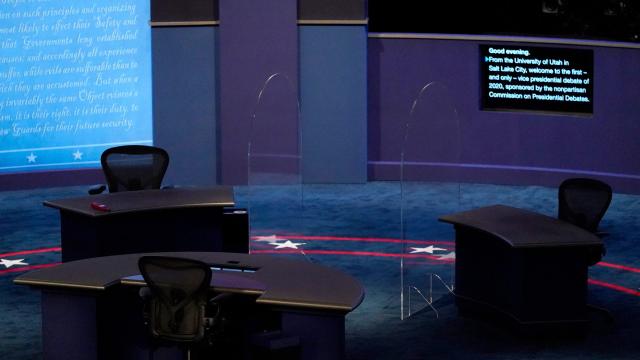The U.S. vice presidential debate tonight between Mike Pence and Kamala Harris looks set to go ahead, despite Pence’s recent exposure to people who later tested positive for the novel coronavirus. Given the pitiful precautions enacted to prevent transmission of the aerosol-spread virus — tiny plexiglass barriers, who do you think you are protecting? — it’s worth wondering: Did the coronavirus plan this debate? And is the coronavirus now controlling U.S. President Trump via tiny levers and buttons in his brain?
For starters, there’s the very normal President Trump, fresh off three days of hospitalisation. To date, there remains no clear indication of when or how Trump contracted the infection, nor detailed information about the current state of his health and the risk of infection he poses to others (on Wednesday afternoon, a memo signed by his attending doctor claimed that Trump had been symptom-free for more than 24 hours, but Trump himself has not made a public appearance since Monday night). His recent tweets are, again, very normal.
More than two dozen White House officials or close political allies to Trump have recently tested positive for the coronavirus, including former New Jersey Governor Chris Christie (currently hospitalized), Utah senator Mike Lee, and longtime consultant Kellyanne Conway. Many of these people attended the September 26 event at the White House Rose Garden where Trump announced his nomination of Amy Coney Barrett to the Supreme Court. This Rose Garden meeting of over 200 people is now thought to have been a super-spreading event for the virus.
U.S. Vice President Mike Pence was also in attendance that day, though the White House claims that Pence continues to test negative for covid-19. The Centres for Disease Control and Prevention cleared Pence for the debate. However, Pence seems to be openly flouting the public health guidelines established by that very same CDC, which calls for individuals to isolate for at least 14 days and practice physical distancing from others following exposure to people with confirmed covid-19.
While it’s impossible to truly know how many people were infectious that day at the Rose Garden, Pence directly sat in front of Mike Lee during the announcement, and he sat across from Kellyanne Conway and Melania Trump, another confirmed positive. Other experts have speculated that Pence was also likely in close contact with Donald Trump himself days prior to his first known symptoms last week, a period of time when infected individuals are contagious.
Following Trump’s hospitalisation, the Biden/Harris campaign called for the plexiglass to be installed as an additional safety measure during the debate — a measure Pence openly mocked, even as the President was hospitalised. After a few days of back-and-forth, Pence’s camp relented on Tuesday.
In truth, though, the plexiglass is more theatre than security. Solid barriers like face shields are most effective at blocking droplets expelled at close range. The candidates will be 3.66 m apart from each other, twice the distance that droplets tend to travel before falling to the ground. The more worrying risk is that tiny aerosols containing the virus can linger in the air and waft over into the mouth or nose of an uninfected person. A small plexiglass barrier is likely no more useful at stopping these aerosols than a tennis racket would be at catching bubbles.
Pence still testing negative is an encouraging sign that he doesn’t have covid-19, but an infection can sometimes take a week or longer to develop, and false negatives on a covid-19 test remain relatively common up to the day that symptoms start. Plus, the White House has clearly been dishonest about test results in the past.
The good-ish news is that even if Pence or Harris is infected and contagious on the debate stage tonight, it’s not a guarantee that they would transmit the virus to one another. Most infections are still thought to be caused through close contact with droplets and/or aerosols, not through long-range aerosols.
At the same time, the U.S. Commission on Presidential Debates doesn’t seem to be taking further steps against preventing airborne transmission, such as installing relatively cheap air filters or even just building a more secure plexiglass barrier with more than one wall for the virus to sidestep. And no one on either side seems to be pushing for simply having the debate conducted remotely, by far the safest option that would make all of this guesswork completely irrelevant.
That brings us back to the big question. The President and Pence, the head of the White House’s coronavirus task force, seem to be doing as little as they possibly can to stop the virus from spreading among their own staff and allies — a microcosm of the administration’s failing response to a pandemic that has killed more than 200,000 Americans. Trump himself told people not to fear the virus on Monday, even as he is currently receiving multiple experimental treatments and a steroid after falling alarmingly ill days earlier.
If the mastermind operative of the Trump 2020 campaign is a trillion coronaviruses stacked on top of each other in a trench coat, well, at least all of this would make sense.
